
L. Subramaniam: Electric Modes
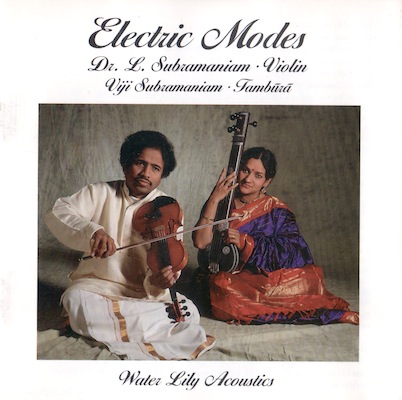
Lakshminarayana Subramaniam: Electric Modes
L. Subramaniam, electric violin; Viji Subramaniam, tambura; uncredited musicians, mridangam and ghatam.
2-CD set Water Lily Acoustics WLA-ES-5&6 (o.o.p.)
Recorded May 1987, Our Lady of Mount Carmel, Santa Barbara; November 1987, Unitarian Church, Santa Barbara; and September 1990, First Presbyterian Church, Santa Barbara. L. Subramaniam and Kavichandran Alexander, producers; Kavichandran Alexander, engineer. (Available via streaming from Tidal; via streaming and MP3 downloads from Amazon; from iTunes; used CDs and LPs are found on eBay and Amazon.)
California’s audiophile label Water Lily Acoustics achieved the dream of most independent music producers by winning the Grammy award in 1994 for Ry Cooder and V.M. Bhatt’s A Meeting By the River. No question, that is a very worthwhile recording.
However, that said, if I had to pick one recording from the Water Lily catalog that was even more musically substantial, it would be L. Subramaniam’s Muddy Waters-inspired Electric Modes. The sound samples over the jump are rather mind-boggling. The original LPs and the CD reissue are long out of print, but through the magic of streaming services, this magnificent music is readily available.
Some background, and the rather stunning sound samples, after the jump. Continue Reading →
Hansi Hinterseer – Hände zum Himmel
(Note: I guess this will have to serve as my belated Oktoberfest post.) Hans “Hansi” Hinterseer (born 2 February 1954) is an Austrian singer, actor, entertainer, and former alpine skier. In 1973 he won the overall giant slalom contest at the 1973 Alpine Skiing World Cup. He also won the silver medal at the world championship in 1974, and participated at the 1976 Winter Olympics in Innsbruck.
Starting in 1994, Hinterseer reinvented himself as a singer in the Schlager genre. Schlager really has no exact translation in English… . It literally means “hits,” but the musical context is, not to put too fine a point on it, a backlash against the post-WWII inundation of European culture first by jazz and then by rock and roll. (Hardly the first, let alone the most, arguable assertion I have made over the past three decades!) Therefore, angst and rebellion are out, and homecoziness und romanze are in.
The above is Hansi & Co. singing and jumping around to what appears to be an inspirational song, and one must agree that the huge live audience appears, um, inspired.
Click on the link for a brief encore of what appears to be traditional Tyrolean music!
Equipment For Making Archival Digital Copies of Vinyl LP Phonorecords (Pt. 1)
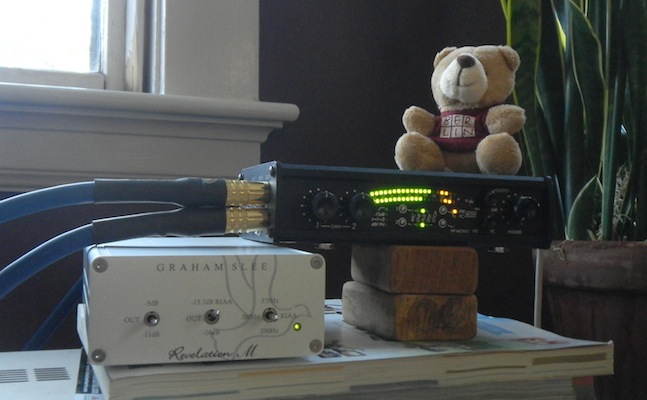 Berlin the Bear staying on top of things in LP-Land. (Photo by John Marks)
Berlin the Bear staying on top of things in LP-Land. (Photo by John Marks)
Time for a new project!
Over the past few years, a new consumer-audio product category has emerged, that of phonorecord playback equipment with the added capability of outputting a digital datastream via USB connection. (I.e., a phono playback stage that also has analog-to-digital conversion and a USB digital output.) The ultimate expression of that concept is a turntable with onboard phono playback equalization and digitization. Such a turntable has both analog outputs for listening and a USB output for recording via a computer or other compatible digital device. Such a package has the advantages of low or low-ish cost, and easy setup. But its cost constraints will lead to sonic compromises, and such setups cannot accommodate pre-RIAA LP discs or 78 rpm records.
So I set myself on a quest to find a Pareto-Principle solution. This will be a four- or five-part series wherein I will discuss alternatives to USB turntables for people who want better performance, or who already have a non-USB turntable they are happy with. Along the way there will be some history lessons, and some practical advice too.
What “Pareto-Principle solution” means; some background on the challenges of storing music on analog physical media; and more, after the jump. Continue Reading →
Anita O’Day: Live at the Newport Jazz Festival 1958
Anita O’Day’s stage surname was Pig Latin for “Dough.” As in money, in that O’Day was always looking for it.
When I mentioned this factoid (factoid in the sense of true, but trivial) to my musically-astute friend, she cracked up, thinking that I meant the musical solfège syllable “Do,” as in “Do-re-mi, etc.” Well, that would have been wearing an insult as a badge of honor… . But, as one can discern from this segment from the documentary film Jazz on a Summer’s Day, O’Day had no trouble finding “Do.”
Dough, however, was another story, in that O’Day was a heroin addict. Heroin use very well might have contributed to this exuberant, bordering on manic, performance.
More, after the jump. Continue Reading →
Andris Nelsons, Lucerne Festival Orchestra – Lucerne Festival 2015 – Gustav Mahler
Wowzers. Gloriosky. Woober joobers. And any other archaic expressions of juvenile wonderment that in former days I would sprinkle into my Stereophile magazine columns for my own and John Atkinson’s amusement. This brief YouTube clip begins with baritone Matthias Goerne, really pulling the taffy of the middle section of one of Des Knaben Wunderhorn‘s most yearning songs, “Urlicht.” There is then a jump cut to a spectacularly energetic excerpt from Mahler’s Fifth. The teaser makes me want to acquire the DVD (Accentus 20354), and makes me even more wish that I had been in the audience at Lucerne in summer 2015 to hear Andris Nelsons conduct an all-Mahler program, cleverly arranged to culminate in Mahler’s Fifth Symphony. Because Mahler started writing that symphony using themes from a Wunderhorn song, “Der Tamboursg’sell.”
DVD boxshot and more musings, after the jump. Continue Reading →
Parker Quartet: Felix Mendelssohn, Opus 44 String Quartets 1 & 3
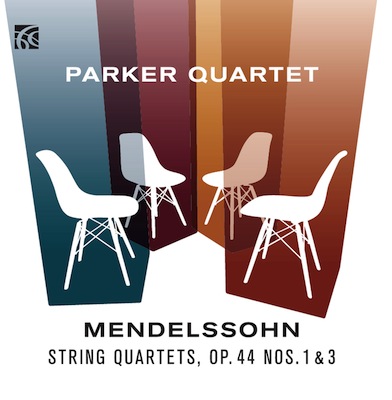 The Parker String Quartet: Felix Mendelssohn, Opus 44 String Quartets 1 & 3
The Parker String Quartet: Felix Mendelssohn, Opus 44 String Quartets 1 & 3
CD Nimbus NI6327
(No high-resolution download available at present, apparently.)
Except for his few “Greatest Hits” (those being the “Wedding March” from A Midsummer Night’s Dream; the Violin Concerto; and the Italian Symphony), I think that Felix Mendelssohn is an often-overlooked or often-underrated composer. Further, given the rarely-equaled felicity (I should be re-programmed) of his solo-piano music, perhaps then it is not surprising that Mendelssohn’s string quartets remain, for many music lovers, undiscovered gems.
The Boston-based Parker Quartet has a name that is new to me, but, it should not have been. Their recording of Ligeti’s first and second quartets received the 2011 Grammy award for Best Chamber Music Performance, and they are the Blodgett Artists in Residence of Harvard University’s Department Of Music. UK’s legendary Nimbus imprint has just released the Parker Quartet’s CD of two of Mendelssohn’s Op. 44 quartets, the first and third. What lovely music making! (I also love that the cover image is of four of Charles and Ray Eames’ fiberglass “scoop” chairs, which are icons of Mid-Century Modern design.)
More, and sound samples, after the jump.
Garrick Ohlsson, Rhode Island Philharmonic, Beethoven “Emperor” Concerto
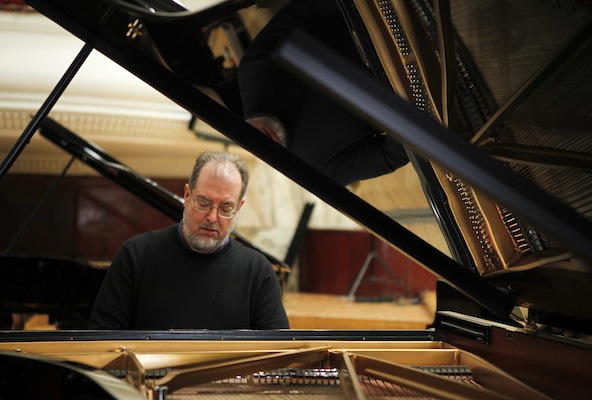
Photo REUTERS © Kacper Pempel, courtesy of Opus 3 Artists
Last Saturday night my musically-astute friend and I attend the opening concert of Maestro Larry Rachleff’s final season as music director of the Rhode Island Philharmonic. Alan Rosenberg of the Providence Journal had asked me to review the concert, so the seats were, as one might expect, excellent. It was a bit of a trip in the WABAC machine (of Peabody and Mr. Sherman fame) to hear soloist Garrick Ohlsson. My high-school girlfriend thought the world of him, while I still vividly recall his Dewar’s Scotch “Profiles” ad that graced the back covers of magazines such as The New Yorker and Playboy when I was in high school. An image of that ad, and more, after the jump.
Sappho: A New Translation by Mary Barnard (1958)
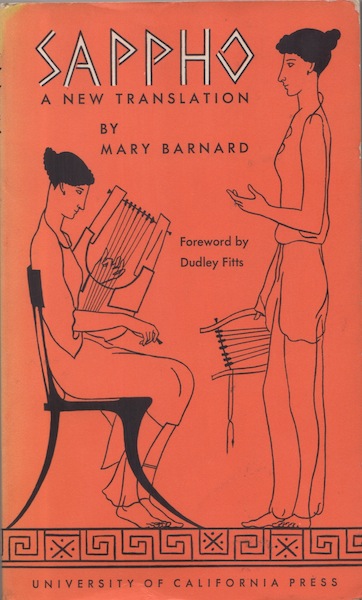
Sappho: A New Translation by Mary Barnard
(University of California Press, Berkeley, 1958)
Kenneth Rexroth is one of my favorite poets. I think that the omission of his poetry from the standard teaching anthologies is unfortunate. Although not a “Beat,” Rexroth was hugely influential upon that generation. Rexroth’s masterpiece of 1944, “When We With Sappho,” keys off a four-line fragment that was all that was known at that time of that particular hymn to Aphrodite of Sappho (died circa 570 BCE). Rexroth’s poem is well worth reading; but parts of it are borderline NSFW. The story is told that in the question period following one of his readings, a lady asked Rexroth whether he had ever tried making love indoors… .
The recommended translation is magnificently translucent–you really get a sense of the person behind Sappho’s poems, middle-aged foibles and all. The 1986 reissue appears to be out of print, but goes for peanuts (offers start at 35 cents plus shipping) on Amazon (link above). Snippets of poetry after the jump. Just buy a few copies of this as impulse presents for friends, plus a copy for the bathroom and a copy for the guest bedroom. (Be sure to read the introduction and the translator’s afterword.)
Morten Lauridsen: “Lux Æterna”
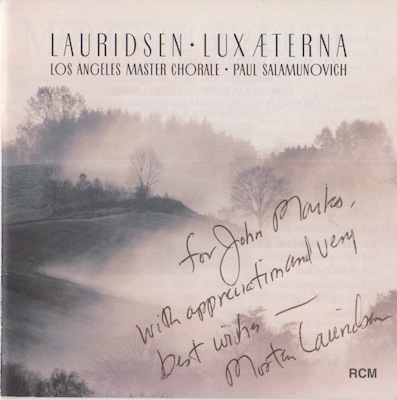
Morten Lauridsen: Lux Æterna and other works
Los Angeles Master Chorale and Sinfonia, Paul Salamunovich, conductor
CD Rubedo Canis Musica RCM 19705
Recorded June 1997 to January 1998, Sacred Heart Chapel, Loyola Marymount University, Los Angeles; Peter Rutenberg, producer; Fred Vogler, engineer.
This recording of Morten Lauridsen’s Lux Æterna was nominated for the Grammy award in its category in 1999. A quick listen to the beginning will tell you why. (A Robert Shaw CD won the award, understandably as it was the year of his death.) Lux Æterna starts with a stroke of genius, and then goes on from strength to strength. The first thing you hear is one of the tallest yet emptiest chords in concert music—the string basses lay down a granite foundation while the high strings harmonize from, it seems, light-years away. And there is nothing in between.
That inspired gesture announces the work as hugely ambitious, while being completely self-assured. Lauridsen is making his personal statement about the meaning of human existence, and nothing less than that. Lux Æterna is one of the masterpieces of the 20th century, and you are really missing out if you have not heard it.
Generous sound samples and more, after the jump. Continue Reading →
Gordon Lightfoot “Talking In Your Sleep” BBC Live In Concert (1972)
Gordon Meredith Lightfoot (born 1938) is most often remembered for his improbable 1976 US #2 hit “The Wreck of the Edmund Fitzgerald,” even though the bad-romance song “Sundown” was his only US #1-charting single.
“The Wreck of the Edmund Fitzgerald” was inspired by a Newsweek item Lightfoot saw by chance while on tour about the loss of an iron-ore freighter in a severe storm on Lake Superior, with the loss of 29 lives. “Sundown” was about a bad-news girlfriend Lightfoot had the good luck to break up with: she later administered the fatal overdose to John Belushi.


